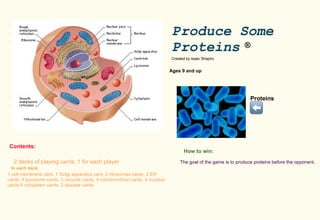
Cell Project Isaac shapiro
- 1. Produce Some Proteins ® Created by Isaac Shapiro Ages 9 and up Proteins ⬅️ Contents: 2 decks of playing cards; 1 for each player In each deck: 1 cell membrane card, 1 Golgi apparatus card, 2 ribosomes cards, 2 ER cards, 4 lysosome cards, 3 vacuole cards, 4 mitochondrion cards, 4 nucleus cards 6 cytoplasm cards. 2 disease cards. How to win: The goal of the game is to produce proteins before the opponent.
- 2. On your turn: 1. In the beginning of the game both players are dealt five cards. 2. You must have a minimum of five cards in your hand at all times and a maximum of seven. In the beginning of your turn you draw a card from your own deck unless you already have seven cards; at the end of your turn you must replenish your cards from your own deck so that you have at least five cards. 3. On your turn you may play up to three organelle cards and only one disease card. 4. Once you play a disease card the opponent can't play whatever organelle they are up to until they replace their lysosome card. 5. If you cannot play any card on your turn then you can replace cards or pass. 6. You can only replace one card per turn. To play a card you must take it out of your hand and place it on the playing floor/table/other. Playing the game: The only way to produce proteins is to play a Golgi apparatus card. In order to play a Golgi apparatus card you must have already played a ribosomes card. To play a ribosomes card you must already have played an endoplasmic reticulum (ER) card. In order to play an ER card you must have already played a lysosome card. In order to play a lysosome card you must have already played a vacuole card. In order to play a vacuole card you must have already played a mitochondrion card. In order to play a mitochondrion card you must have already played a nucleus card. You cannot play a nucleus card before you play a cytoplasm card. Each player starts out with their only cell membrane card. You can play a disease card whenever you want as long as the other player has a lysosome card played. A disease card destroys a lysosome card from the opponent. The only way to get proteins is to play a Golgi apparatus card because they are the ones to check the "package" or in this case the ribosomes,to see if there are any mistakes. Before you can play a Golgi apparatus card you need to play a ribosomes card because ribosomes make proteins. If you have a Golgi apparatus with no ribosomes then you can't produce proteins and if it was vice versa than there would be mistakes in the proteins. The reason that you need to have an ER card before a ribosomes card is because the ribosomes are the workers inside of the ER, which is the pathway through the cell. The reason you have to play a lysosome card before you can play an ER card is because a lysosome keeps the cell clean and if the cell isn't clean then it can't function correctly. Also lysosomes can help protect against diseases and that is very important in a cell. You can't play a lysosome card before you play a vacuole card because the vacuole is the storage unit in a cell and without storage in a cell everything that needs to be stored in a special unit won't be stored. Then the cell won't be able to function. The reason that you need to play a mitochondrion card before all of these other cards is because nothing can function in a cell without a mitochondrion, because a mitochondrion produces energy. The reason that you can't play even a mitochondrion before a nucleus is because a nucleus is the card that tells every other organelle what to do, and without a nucleus then none of the organelles will know what to do. The reason that the cytoplasm has to be played first is because the cytoplasm is the cell floor and organelles can't be in a cell unless they are on cytoplasm. The reason that you automatically start with a cell membrane is because the cell membrane controls what goes in and out of a cell. When one player plays a disease card on the other player, the other player loses a lysosome card because lysosomes fight off diseases when they enter a cell.